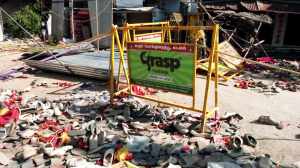Country model
If you’re predetermined to dismiss rural India with a sigh or a sneer, then visit western Maharashtra.Across the region, villages are o...

If you’re predetermined to dismiss rural India with a sigh or a sneer, then visit western Maharashtra.
Across the region, villages are opting for HIV/AIDS tests for brides and grooms, proudly flaunting 100 per cent sanitation certificates from the administration, embracing alternative energy sources, efficient self-government and water management, greater role for women, family planning, bio-gas fired kitchens — you name it.
But both villagers and the administration agree this change of mindset rides on the willingness to bend the back and perspire. From laying new roads to building temporary dams to sweeping the village out, the policy is do-it-yourself.
Leading the charge in this are three villages — Kaldhari in Purandar district, Jainyal and Kambalwadi in Kolhapur.
KALDHARI — an almost-inaccessible hilltop village located in a traditionally parched region of Maharashtra — has topped the district cleanliness ‘competition’ called the Sant Gadge Baba Swacchata Abhiyan — five times in a row, including in 2004-05.
‘‘Every one of the 2,250 villagers here are ‘sweepers’; we have no one appointed specially for the job,’’ says proud sarpanch Ankur Divkar Parkhande, as kids lug small plastic buckets to water a stretch of newly-concretised street.
When Parkhande says ‘‘no sweepers employed here’’, he is including the toilets as well. For, every one of the nine public and 327 private toilets is hooked up to one of the 110 bio-gas plants that dot the village. ‘‘The waste is converted into gas, which is then piped to the kitchens,’’ adds Parkhande.
But Kaldhari isn’t satisfied with being just squeaky clean. Apart from paved roads, the village has brought in environment consciousness and partially reduced dependency on the Maharashtra State Electricity Board (MSEB), by installing solar-powered streetlights, an aero-generator (a small wind turbine) that can power 40 electric lamps.
The mainstay business of Kaldhari and its six wadis is milk. So, to consolidate it, the villagers have installed a Rs 17 lakh, 6000-litre capacity milk chilling plant that supplies much of its produce to Pune.
JAINYAL, with a population of 1,508, stood first for cleanliness in the division-level competition last year. This time, Jainyal’s success has seen more villages compete, resulting in the village having to share third place with Chorkhambra.
‘‘Election campaigning is not allowed here — no posters, banners, badges, rallies. Still, over 93 per cent cast their vote in last year’s Lok Sabha and Assembly elections,’’ says sarpanch Vakoji Krisna Gurav. Since 2002, villagers here have collectively removed road encroachments and achieved 100 per cent sanitation.
Now, the 80-member Adarsh Gramsewak — a youth group for cleanliness — is aiming to clean 52 villages in the district. To preserve the ecological balance, 36,000 trees have been planted, while all streetlights are solar-powered. Financial security is also high on the priority list, with the entire population insured under an LIC scheme.
To empower women, each and every house is registered in the names of housewives, which adds to the 22 women’s self-help groups (SHG) and the two women members in the panchayat.
Kambalwadi credits gramsewak Sagar Sarawane with having taken the bulk of the initiative, which saw the village stand first at the taluka level for 2004-05, in cleanliness measures. This, with a population of hardly 1,003. The 100 per cent sanitation came after the gram panchayat convinced all 156 families to build individual toilets.
Here, waste water is recycled and supplied to banana, neem and duranta plantation, generating income and preventing pollution. There’s a ban on borewells deeper than 100 feet, and on cutting trees.
Like Kaldhari, almost 95 per cent of human waste is used to generate bio-gas through 104 units. What’s more, the plastic is separated from the rest of the garbage and converted to organic fertiliser through vermiculture.
Under non conventional energy resources management, nine solar cookers are provided as models to educate housewives, while smokeless stoves are also in use. This year, the village will get photovoltaic streetlights from the Zilla Parishad, the MLA fund and the panchayat fund. ‘‘This will save Rs 1 lakh in MSEB bills,’’ says Sarawane.





- 01
- 02
- 03
- 04
- 05


























